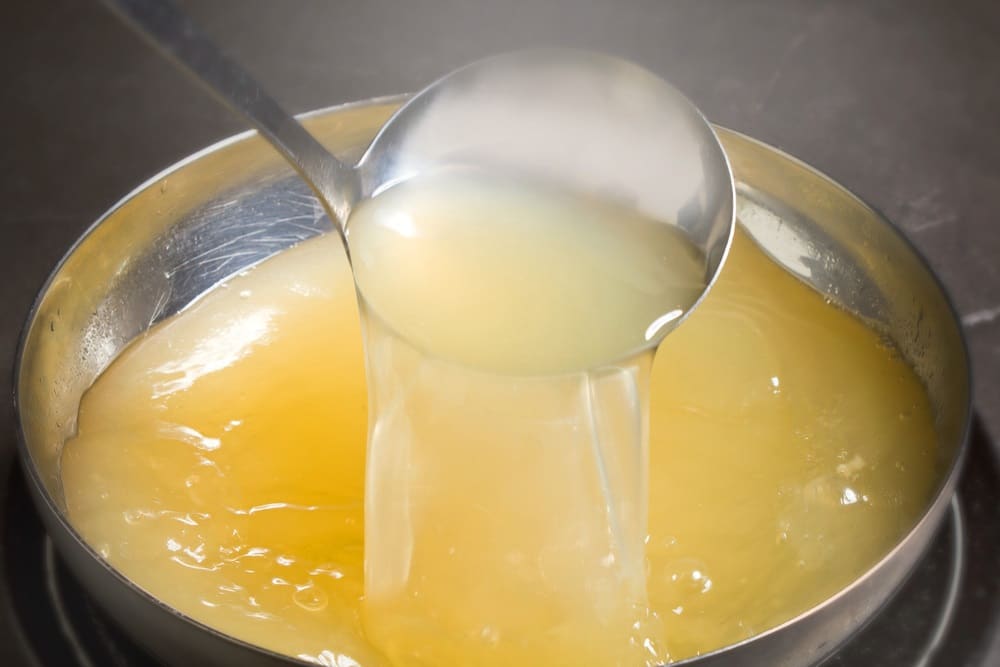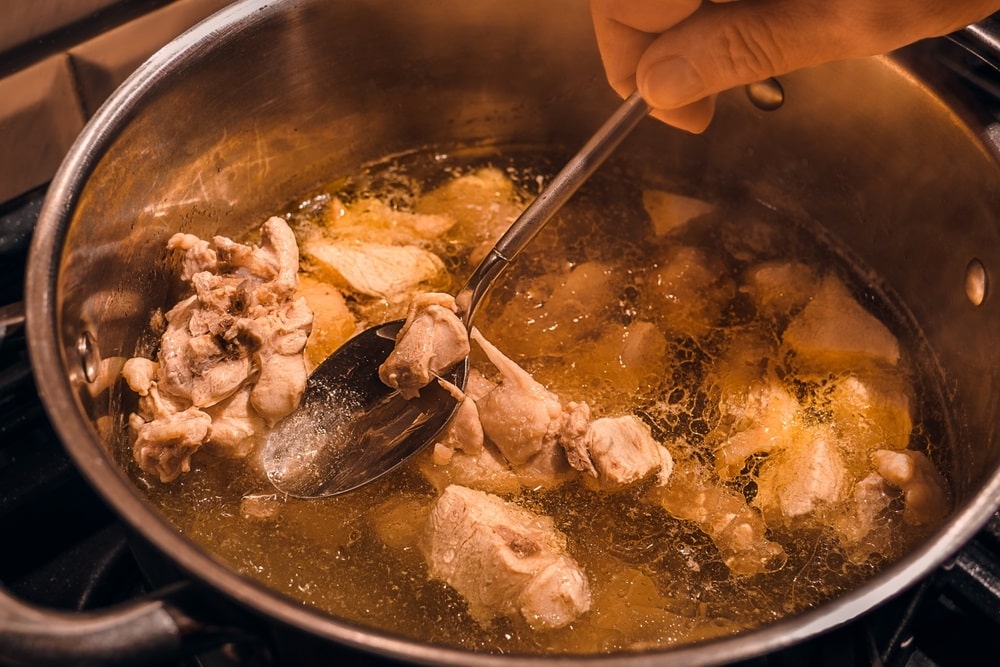
Chicken broth is such a useful staple to have in the kitchen, whether you make your own or buy it ready-made.
It can be served as a clear consommé or broth for a starter or used as a base for chicken soups, casseroles, stews, and curries.
Most poultry recipes will call for the addition of broth (otherwise known as stock) rather than water, and if they don’t, feel free to substitute it in for extra flavor!
How is Chicken Broth Made?
Chicken broth is made by slowly cooking chicken pieces or bones in water with root vegetables like carrots and onions, plus herbs such as thyme.
Once the poultry is cooked and the flavors have infused, the solid bits are strained out and the resulting richly-flavored water is known as “broth.”
Traditionally, broth or stock is supposed to be clear rather than cloudy. While this is not that important for most homecooked dishes, perhaps you are making a dish that requires clear broth to be perfect.
In this case, you may be wondering why your chicken broth is cloudy and what you can do about it.
Why Is My Chicken Broth Cloudy?
Cloudiness usually happens when the meat juices leach into the cooking water and form clumps as they heat up. Most of this rises to the top as scum and can be scooped off.
If the liquid boils too hard or is stirred, the clumps get broken into minute pieces that disperse throughout the broth, causing it to appear cloudy.
While this will not spoil the flavor of the finished dish, it is unacceptable for certain recipes. Luckily, there are many easy ways to avoid and fix cloudy broth.
Seven Reasons Your Broth is Cloudy and How to Fix the Problem
1. No soaking.
Before beginning to make your broth or stock, soak any meat or bones you plan to use in cold water for about an hour. Then discard this water. This will remove any blood or impurities like bone dust.
2. Boiling hard rather than simmering.
Broth should be cooked at a very gentle simmer, never boiled vigorously. If you want to check the temperature range, this would be between 160 and 180 degrees Fahrenheit (71 to 82 degrees Celcius).
Vigorous cooking dislodges particles from the vegetables and meat and releases them into the liquid, producing a cloudy result.
3. Agitating and stirring.
Treat your broth gently and never stir it or agitate it in any way while it is cooking. This will prevent the vegetables from breaking up and bits of meat from becoming dislodged. These would make the broth cloudy.
Pressure cooking the broth makes it easier not to agitate it as when pressure cooking, the liquid stays still and doesn’t bubble vigorously. Any protein clumps that form from the meat stay together and can be strained off once the cooking process is over.
4. Forgot to skim.
Skimming is the process of scooping impurities off the top of the broth as it is simmering. For the first hour of cooking, this should be done every 10 minutes using a straining spoon.
The scum comes from the meat and should all be removed and discarded along with any fat that rises to the top.
5. Did not strain.
For perfect clarity, your finished broth needs to be strained first through an ordinary sieve or colander to remove all the pieces of meat and vegetables, then through a very fine mesh strainer.
To finish off, you can pass it through a strainer lined with butter muslin (this has a finer weave than cheesecloth) to remove the tiniest impurities that are left.
If you only have cheesecloth, fold it into three or four layers, wet it, then line your sieve with it. Pass the broth through this and it will become almost perfectly clear.
6. Did not use a raft.
Chefs use this fairly simple method to obtain crystal-clear stock. The only disadvantage is that you may lose a little flavor in the process. Take your cooked and strained broth and put it into a clean saucepan. Heat it gently to about 50 degrees Celcius.
Now, whip one egg white for every liter of stock plus crushed eggshells and gently stir this mixture into the stock. Stop stirring and watch what happens. As the broth heats past 60 degrees, the egg whites will cook and clump together with the shells on top of the broth.
Any impurities will be trapped inside the raft. Leave this to happen for five minutes then remove the broth from the heat. Skim the raft off the top and discard it.
Now pass the broth through a fine, wet piece of muslin once more. Discard the egg raft. You should now have a beautifully clear broth.
7. Cut the vegetables too finely.
When preparing the vegetables for broth, cut them into chunks rather than finely chop them. This is because small bits of say, carrot and onion, will dissolve into the broth as it cooks and make it cloudy.
Conclusion
For home cooks, unless you are making a recipe that needs an immaculately clear broth, it is fine if your broth is a little cloudy. Your soup, stew, or curry will still be a success and nobody will notice any difference.
In the end, the most important thing is the flavor of your broth, not how clear it is. Unless you are a chef in a fine dining establishment, there is no need to worry about a little cloudiness in your chicken broth.

